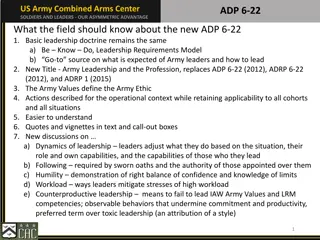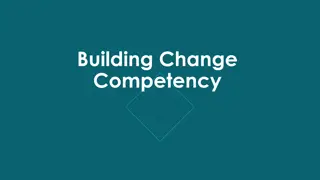Understanding Leadership and Change Management in Organizations
Leadership is not defined solely by position, but as a choice to influence and inspire others towards a common goal. This chapter delves into the essence of leadership, highlighting its behavioral approach, social influence, and importance in organizational success. It discusses the functions of management and leadership, emphasizing the need for both formal authority and informal influence within a group to achieve collective goals effectively.
Download Presentation

Please find below an Image/Link to download the presentation.
The content on the website is provided AS IS for your information and personal use only. It may not be sold, licensed, or shared on other websites without obtaining consent from the author. Download presentation by click this link. If you encounter any issues during the download, it is possible that the publisher has removed the file from their server.
E N D
Presentation Transcript
Leadership and Change Management (MBA5023) Chapter One: INTRODUCTION BY: Yissa Hassen (Ph.D Scholar) March, 2020 Debre Tabor, Ethiopia
Who is a leader? There is a leader in everybody Leadership is not only a function of position, but it is a choice
What is Leadership? A process where by an individual influences a group of individuals to achieve a common goal
1.1: Leadership Definition The term leadership means to lead people. The behavioural approach of human behaviour about a person, group, people etc. It is a process to influence people by the leadership quality. Leadership behaviour approach of human behaviour. It influences people to give best performance in the organisation. It is the process in which follower and leaders lead. psychological is a
Contd. leadership is the process of social influence in which one person can enlist the aid and support of others in the accomplishment of a common task . M Chemers. "Leadership is ultimately about creating a way for people to contribute to making something extraordinary happen." Alan Keith.
Contd. Leadership (meaningful direction) to collective effort, and causing willing effort to be expended to achieve purpose. (Jacobs & Jaques, 1990). Leadership is the ability of an individual to influence, motivate, contribute toward the effectiveness and success of the organization.(House et al., 1999) Leadership is the ability communicating a vision to a group of people that will make that vision true (Kenneth Valenzuela, 2007) is a process of giving purpose and enable others to of developing and
Leadership & Management MANAGEMENT LEADERSHIP Requires five functions: planning, A major part of a manager s job organizing, staffing, leading and controlling Emerge formally. Managers need The leader of the work group may formal authority to be effective. emerge informally as the choice of the group. Deals with both the interpersonal Deals with the interpersonal aspect of a and administrative aspect of a manager s job. manager s job. Managers deals more with carrying Deals with change, inspiration, out the organization s goals and motivation and influence maintain equilibrium
MANAGEMENT LEADERSHIP Managers may have to rely on formal Leaders may not possess the formal authority to get employees to power accomplish goals. Groups are often more loyal to a Groups are often more loyal to a leader leader than a manager than a manager Managers focus on system and Focus on people structures Managers relies on control Leaders inspires trust Managers imitates Originates Accepts the status quo Challenges the status quo Managers asks how and when Leaders asks what and why
1.2. Manager vs Leader LEADERS Innovative Develop Inspire Originate Long term view Ask what & why Challenge the status Do right things MANAGERS Administer Maintain Control Short term view Ask how & when Initiate Accept the status Do things right.
1.3. What Makes Effective Leadership Effective leadership is the process of achieving desired results through people s willing participation. The heart of this definition is: desired results (goals), through people, and willing participation-people willingly follow leaders because they want them. When leaders are effective, the influence they exert over others helps a group or organization achieve its performance goals when leaders are ineffective, their influence does not contribute to, and often detracts from, goal attainment.
Contd. Beyond facilitating the attainment of performance goals, effective leadership increases ability an to meet all the organization s contemporary challenges- including the need to obtain a competitive advantage, the need to foster ethical behavior, and the need to manage a diverse workforce fairly and equitably.
Contd. Warren Bennis, who devoted decades to researching leadership issues, concludes that virtually all leaders of effective groups share four characteristics in common: 1. They provide direction and meaning to the people they are leading. This means they remind people what is important and why what they are doing makes important difference. 2. They generate trust. 3. They favor action and risk taking. That is, they are proactive and willing to risk failing in order to succeed. 4. They are surveyors of hope. In both tangible and symbolic ways they reinforce the notion that success will be attained.
1.3. Qualities of leadership Intelligence Risk taking behaviour Positive attitude Problem solving Knowledgeable Better communication Strong determination Wisdom
Contd.Qualities of leadership Kind hearted Passion Creativity Vision Confidence Teaching ability (being model). Readiness to accept responsibility / criticisms and to take appropriate corrective measures Emotional stability and fairness Planner and organizer E.t.c
Contd. Leader - You must have an honest understanding of who you are, what you know and what you can do. To be successful you have to convince your followers not your superiors, that you are worthy of being followed. Follower -You must know your people. The fundamental starting point is having a good understanding of human nature, such as needs, emotions and motivation.
Contd. Communication-The nonverbal communication is leading. E.g.- when you set example that communicates to your people that you would not ask them to perform anything that you would not be willing to do. Bad communication harm the relation employee. Situation-We must use our judgment to decide the best course of action and the leadership style needed for each situation. What we do in one situation will not always work in another. between leader and
Contd. It is an interpersonal influencing, exercised in situation and directed through the communication process towards the attained of a specified goal or goals. It is process of getting other people to follow you and to do willingly the things that is you want them to do. It is influencing people to follow you to work willing for the achievement of goal & objective.
Reading Assignment Discuss the Importance of leadership for good governance and development























